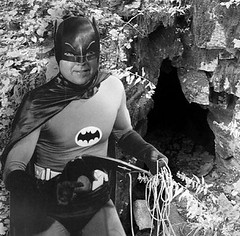
Posted on 10/17/2005 8:57:32 AM PDT by Fzob
Sept. 28, 2005— A supernova blast 41,000 years ago started a deadly chain of events that led to the extinction of mammoths and other animals in North America, according to two scientists.
If their supernova theory gains acceptance, it could explain why dozens of species on the continent became extinct 13,000 years ago.
Mammoths and mastodons, both relatives of today's elephants, mysteriously died out then, as did giant ground sloths, a large-horned bison, a huge species of armadillo, saber-toothed cats, and many other animals and plants.
Richard Firestone, a nuclear scientist at the U.S. Department of Energy's Lawrence Berkeley National Laboratory, who formulated the theory with geologist Allen West, told Discovery News that a key piece of evidence for the supernova is a set of 34,000-year-old mammoth tusks riddled with tiny craters.
The researchers believe that in the sequence of events following the supernova, first, the iron-rich grains emitted from the explosion shot into the tusks. Whatever caused the craters had to have been traveling around 6,214 miles per second, and no other natural phenomenon explains the damage, they said.
They think the supernova exploded 250 light-years away from Earth, which would account for the 7,000-year delay before the tusk grain pelting. It would have taken that long for the supernova materials to have showered to Earth.
Then, 21,000 years after that event, the researchers believe a comet-like formation from the supernova's debris blew over North America and wreaked havoc.
Firestone said they think the formation created superheated hurricanal winds in the atmosphere that rolled across North America at 400 kilometers per hour (about 249 mph).
"The comet (-like event) was followed by a barrage of hot particles. If that didn't kill all of the large animals, then the immediate climate changes must have," said Firestone.
Firestone said smaller animals could have sought shelter more readily, by going into caves or underground.
The findings were presented at last weekend's "World of Elephants" international conference in Hot Springs, S.D.
In addition to the tusk evidence, the scientists said arrowheads from North America's prehistoric Clovis culture, which went extinct around 13,500-13,000 years ago, Icelandic marine sediment, as well as sediment from nine 13,000-year-old sites in North America, contain higher-than-normal amounts of radiation in the form of potassium-40 levels.
Potassium-40 is a radioactive isotope, meaning a molecule that emits radiation.
Magnetic particles also were unearthed at the sites. Analysis of these particles revealed they are rich in titanium, iron, manganese, vanadium, rare-earth elements, thorium and uranium.
These elements all are common in moon rocks and lunar meteorites, so the researchers think the materials provide additional evidence that North America was bombarded 13,000 years ago by material originating from space.
Luann Becker, a University of California at Santa Barbara geologist, told Discovery News she was not surprised by the new supernova theory, since extinction events have been linked to similar comet or asteroid impacts before.
"What is exciting about Dr. Firestone's theory is that it can be easily tested," Becker said, and indicated she hopes future research will yield additional clues from North American and other sediment layers.
You beat me to it!
Hopefully, you have fully recovered your sense of hearing...
and your sense of musical taste.
I just love it when scientist come up with a new "theory". Can anyone do that? If so, how 'bout my theory. There is a God and he created everything. Well, I can't disprove those two scientists but then, they can't disprove my theory either.
One would have thought that this was obvious to any researcher, but I suppose the PC crowd wants to maintain their delusions regarding the Innocent Savages of North America.
M. Rousseau would be proud.
If these retards found it in several hundred sets of mammoth tusks spread across the entire continent I might have a chance of believing it.
Also if this was true it would have wiped out all large animals at the same time across the planet. Humans included
Supernova debris does not spread out on a totally even wave front. Otherwise SN1987A would have been a giant flashbulb and burned out.At 250 light years there would have also been hard radiation shining well in excess of safe levels for more than o0n planetary roation as well.
but exactly 6214 miles per second
corresponds to 10,000 km/sec.

cool find. thanks for posting. bookmark for later printing.

The problem with the human hunter explanation can be found in Southern and Southeastern Asia where the elephant and tiger as well as large apes, etc. survive beside rather large and culturally highly developed human populations. Still questions. Personally, I doubt any one answer will suffice. Certainly climate change -- global warming without SUV's if you will -- is part of the answer in the Northern Hemisphere. That along with the spread of humans, that is.
JUST DAMNN!

Actually, anything large enough to strike at 6,214 miles per second, and yet reach the ground without burning up in the atmosphere, would not merely "impact" OR "perforate" a mammoth tusk. I tend to think it would vaporize the tusk, plus the other tusk, plus the rest of the mammoth, plus the whole remaining herd of mammoths, plus everything else including solid rock for a hemispherical radius of hundreds or thousands of feet.
-ccm
Mammoths died out because they couldn't find anything in a 4,000 Long with 2 pairs of pants!
and not just the tusk, but the whole elephant, and everything else around. 6K miles per second is moving.
So this is why Kenniwick Man went extinct and a later wave of Asian trespassers inherited America?
LOL!
Disclaimer: Opinions posted on Free Republic are those of the individual posters and do not necessarily represent the opinion of Free Republic or its management. All materials posted herein are protected by copyright law and the exemption for fair use of copyrighted works.